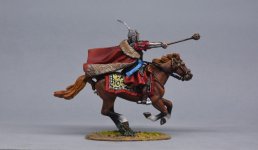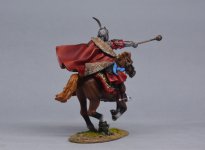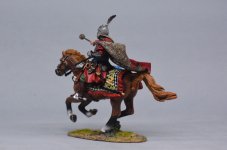TeamMiniatures
Private 2
- Joined
- Oct 21, 2019
- Messages
- 140
Hello Collectors!
Thank you for waiting!
The first 3 Polish Winged Hussar have finally come out, and I am quite satisfied with the overall effect, I hope you will like them. At the same time, I am very eager to get everyone's opinions and suggestions.
We can arrange shipment of VEA6001 to VEA6003 by the end of this month. Not only, we give you an early preview at two new unpainted Hussar, one with a knife, and one with a lance, and two new ones are being carved.
Do you have any more outrageous ideas for developing new Winged Hussar? Let me know!!
Have a great weekend!
T.M. Jack
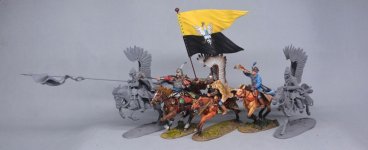
John III Sobieski, King of Poland (1629-96)
The most famous of all the Polish kings, Sobieski's achievements at Vienna have straddled the centuries, and he remains an impeccable hero to many Poles today. Born into a wealthy and distinguished family from Volhynia (western Ukraine), he learnt from an early age that the prosperity of his family was bound up in the fortunes of the frontier province. In 1648, at the end of a two-year tour of Europe where he studied mifitary science and fortifications, he returned to Poland and was engulfed in the Cossack rebellion (1648-54) of Bohdan Khmelnytsky. Raising and commanding his own banner of cavalry (100-200 men) his military talents were quickly revealed, and following a crushing Polish victory at the Battle of Berestechko(1651), where he fought with distinction, he was sent by King John II Casimir to be the Polish envoy at the Ottoman court. Whilst there he studied the Ottoman military traditions and tactics and learned the Tatar language.
In 1655 the First Northern War erupted, and Sweden overran Poland in what became known as the 'Bloody Deluge', Sobieski was part of a Greater Polish regiment that capitulated at Ujscie and swore allegiance to Charles X Gustav of Sweden. In less than a year, however, he returned with his unit to the Polish side and fought for the Polish king in the two three-day battles at Warsaw, where he commanded his 2,000-strong Tatar cavalry force with such distinction that he was promoted to be Crown Standard Bearer. He was a strong supporter of the French faction and remained loyal to the crown during Lubomirski's Rebellion (1665-66) and he was promoted to Crown Field Hetman in 1665. After the victory over the Cossacks and their Tatar allies at the First Battle of Podhajce (1667) he was promoted to Grand Crown Hetman, the highest rank in the Polish--Lithuanian Commonwealth and that of the commander-in-chief of the entire Polish army. The victory that really set him on his way to greatness was at the Battle of Chocim(1673) where he defeated the Ottomans in a monumental struggle and captured its powerful eponymous fortress. With news of the battle and of the death of King Michael Korybut Wisniowiecki spreading simultaneously across the country, sobieski soon became a strong candidate for king. The following year he was elected as the new monarch, and in February 1676 he was crowned John III Sobieski.
Sobieski was the model warrior hero for his time, spiritually sharp with a strong Catholic faith, and a decisive and vigorous man. Unlike Leopold, he tolerated Jews and Protestants within his realm. He attempted to provide Poland with a stronger institution of government and desired to establish permanent borders and security for Poland, notably in his attempt to establish an international coalition against Islam. In spring 1683, spies uncovered Ottoman preparations for a campaign, ostensibly against the southern borders of the Polish-Lithuanian Commonwealth; as a result, Sobieski began to fortify the cities of Lvov and Cracow and ordered universal military conscription.
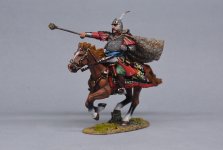


Thank you for waiting!
The first 3 Polish Winged Hussar have finally come out, and I am quite satisfied with the overall effect, I hope you will like them. At the same time, I am very eager to get everyone's opinions and suggestions.
We can arrange shipment of VEA6001 to VEA6003 by the end of this month. Not only, we give you an early preview at two new unpainted Hussar, one with a knife, and one with a lance, and two new ones are being carved.
Do you have any more outrageous ideas for developing new Winged Hussar? Let me know!!
Have a great weekend!
T.M. Jack

John III Sobieski, King of Poland (1629-96)
The most famous of all the Polish kings, Sobieski's achievements at Vienna have straddled the centuries, and he remains an impeccable hero to many Poles today. Born into a wealthy and distinguished family from Volhynia (western Ukraine), he learnt from an early age that the prosperity of his family was bound up in the fortunes of the frontier province. In 1648, at the end of a two-year tour of Europe where he studied mifitary science and fortifications, he returned to Poland and was engulfed in the Cossack rebellion (1648-54) of Bohdan Khmelnytsky. Raising and commanding his own banner of cavalry (100-200 men) his military talents were quickly revealed, and following a crushing Polish victory at the Battle of Berestechko(1651), where he fought with distinction, he was sent by King John II Casimir to be the Polish envoy at the Ottoman court. Whilst there he studied the Ottoman military traditions and tactics and learned the Tatar language.
In 1655 the First Northern War erupted, and Sweden overran Poland in what became known as the 'Bloody Deluge', Sobieski was part of a Greater Polish regiment that capitulated at Ujscie and swore allegiance to Charles X Gustav of Sweden. In less than a year, however, he returned with his unit to the Polish side and fought for the Polish king in the two three-day battles at Warsaw, where he commanded his 2,000-strong Tatar cavalry force with such distinction that he was promoted to be Crown Standard Bearer. He was a strong supporter of the French faction and remained loyal to the crown during Lubomirski's Rebellion (1665-66) and he was promoted to Crown Field Hetman in 1665. After the victory over the Cossacks and their Tatar allies at the First Battle of Podhajce (1667) he was promoted to Grand Crown Hetman, the highest rank in the Polish--Lithuanian Commonwealth and that of the commander-in-chief of the entire Polish army. The victory that really set him on his way to greatness was at the Battle of Chocim(1673) where he defeated the Ottomans in a monumental struggle and captured its powerful eponymous fortress. With news of the battle and of the death of King Michael Korybut Wisniowiecki spreading simultaneously across the country, sobieski soon became a strong candidate for king. The following year he was elected as the new monarch, and in February 1676 he was crowned John III Sobieski.
Sobieski was the model warrior hero for his time, spiritually sharp with a strong Catholic faith, and a decisive and vigorous man. Unlike Leopold, he tolerated Jews and Protestants within his realm. He attempted to provide Poland with a stronger institution of government and desired to establish permanent borders and security for Poland, notably in his attempt to establish an international coalition against Islam. In spring 1683, spies uncovered Ottoman preparations for a campaign, ostensibly against the southern borders of the Polish-Lithuanian Commonwealth; as a result, Sobieski began to fortify the cities of Lvov and Cracow and ordered universal military conscription.



Last edited:


